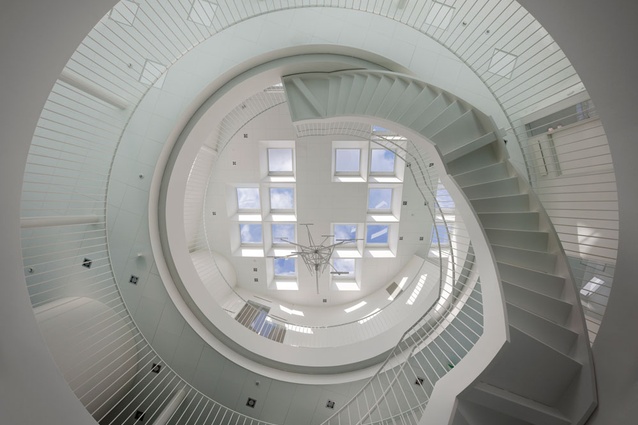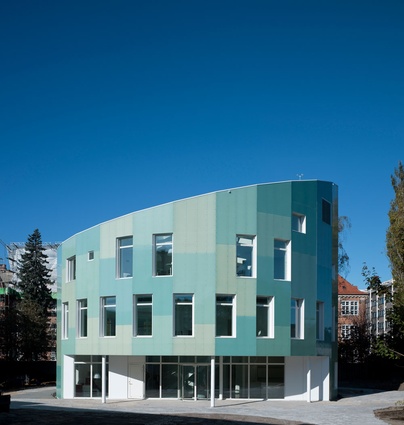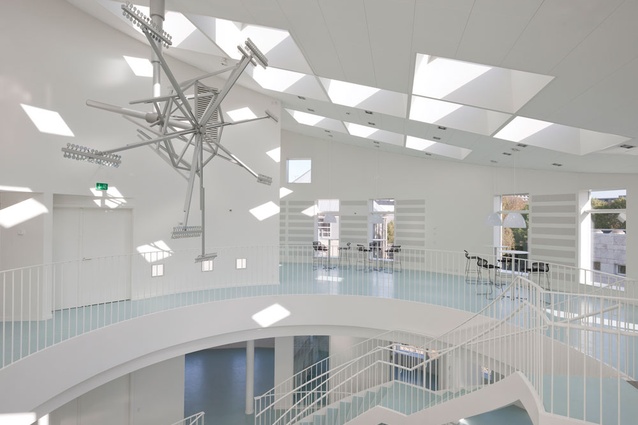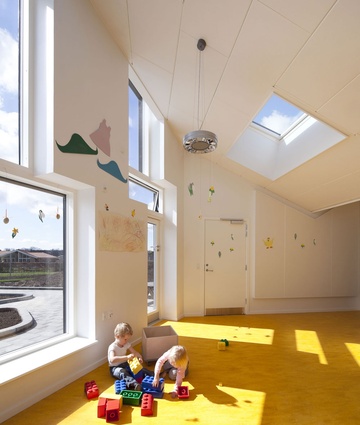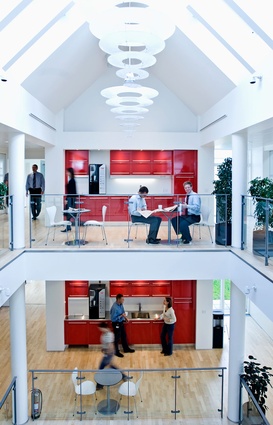Walking in light
Michael Barrett visits Copenhagen's 'Green Lighthouse' and finds that healthy interiors and building efficiency walk hand in hand.
Thirty-odd hours on the plane and then it’s hej! (or hello) Copenhagen, variously named most liveable city in the world, or some variation thereof, and it’s home to a number of architectural wonders, like the Øresund Bridge, the Copenhagen Operaen, any number of churches and a newish Metro that gives hope to those of us in similar-sized cities that public transport infrastructure commitments are not beyond the realms of possibility in small countries, this century. There’s also tax, as high as 52 per cent for some, and green tax too. For a decade the Danes have integrated environmental considerations into their tax system. Green tax reform, it’s said, has meant that consumers have asked for cleaner products and in response, its industries has invested in materials and processes that have less impact on the environment.

Some such ‘clean-tech’ processes are building related. Danish company VKR Holding owns 26 companies that are daylight- and fresh air-related, Velux and Windowmaster are just two of them. Inter alia, one reason why I found myself in the fair city of Copenhagen was to tour several buildings where an emphasis was on the provision of healthy interior spaces via techniques of natural ventilation and daylighting. Kindergartens and schools, corporate offices, new builds and retrofits, including the wonderfully ambient VKR HQ (right), were all on the menu daily, as was the carbon neutral Copenhagen University study centre called Green Lighthouse. As you would expect form a culture that prides itself on its egalitarianism, these were all without exception people-centric places that had interior spaces with an indefinable calm. Indefinable, that is, until you realised the quiet was a result of an absence of mechanical white noise. A negative detail par excellence.
So, what were these miraculous places? The headquarters of Danish publishing group Aller, located on Havneholmen, in the centre of the Copenhagen harbour, had a huge preponderance of glass in its façade. Potential overheating was alleviated by automated windows in the atrium roof and façade. Controlled by a computer, the ‘pulsing’ of these was based on input from indoor temperature and CO2 sensors and outdoor climate info such as rain, wind speed and temperature.
A surprising visit was to what might have been the most boring site: the shopping mall Fields, the biggest mall in Denmark, built 10 years ago with mechanical ventilation, but now retro-fitted with operable windows. Despite having to replace many fixed windows, and factoring in the installation of motors and control systems, the owner expects a return on investment within three years, and that’s calculating only the reduced energy costs for mechanical ventilation, and not considering the restorative (and potentially wallet-opening) properties of fresh air.
A lesson for our own big box retailers? The question, naturally, is that if these natural ventilation and daylighting techniques can be employed successfully in a country with greater variances in temperature than ours, then what could be the benefits in terms of healthier working and learning environments, as well as energy efficiency, for us in our more temperate clime? This seems applicable as we start to look at refurbishing our cities’ ageing building stock.
That’s not to say, however, that we’re averse to implementing these ‘Danish’ techniques. Stephenson & Turner recently received a 6 Green Star rating for its Wellington studio; its design maximises daylight and ventilation through eight operable skylights that work with a lighting system that adjusts artificial light in accordance with the amount of available daylight.

Back in Denmark, the Green Lighthouse, located on the Nørre Campus of the University of Copenhagen, is home to the Faculty of Natural Sciences student service centre. It’s part of the ‘Active House’ network, a building designed to “give more than it takes”; an exemplar of low-energy building that also promotes the benefits of a healthy indoor climate. The hallmark of the building is its energy concept — a combination of thermal solar heating, seasonal storage of energy and district heating. The Active House network is about setting up a “holistic framework” for the design and renovation of buildings “in order to make a positive contribution to human health and well-being by focusing on indoor and outdoor environments as well as sustainable energy”. By bringing energy, daylight and fresh air into focus, the organisation wants to promote better environments in cultural, architectural and environmental terms. The sentiments, expressed via case studies on its website, suggest that buildings have the potential to save huge amounts of energy through consideration of natural light, thermal properties of building materials, and building form in relation to sun path and reduced outer surface area. Buildings of the future, it says, must be opened up to exploit daylight and passive heat — and so it goes at the Lighthouse. The building is a circular structure, inspired, said architect Michael Christensen (see Q+A with the architect here), by the sundial and the movement of the sun. (Photos of another of the architect’s projects, Sølhuset – or Sun House – also an Active House project, can be seen above.)
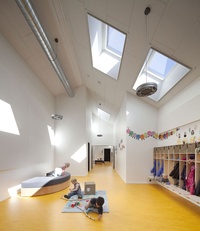
Technologies on site include use of a new temperature-regulating material called PCM (the building’s exterior cladding), insulated windows, motorised sunshades on the façade that open and close as the sun moves around the building, and motorised windows positioned in relation to the movement of the sun in order to allow for maximum use of natural light, which draw in fresh air from optimal locations to ensure energy efficiency. An inclined roof ‘collects’ daylight and the roof surface is also the main power source, with solar energy captured by both solar panels. Low-energy windows and 400mm-thick insulation help the building keep a consistent indoor temperature.
The interior countenance is crisp, white and brilliantly calm. It’s controlled with an automation product called NV Advance, a Windowmaster product that controls windows, temperature, C02, light and movement sensors. The overall benefit of the control system is that it ensures that the least energy-consuming energy form is used at any time. This is done through continuous measurements of room temperature, CO2 level, light level and outdoor data from a rooftop weather station that registers outdoor temperature, wind speed and direction, sunshine and rain. Phew. Its complicated, but surprisingly easy to operate.
Green Lighthouse is not over-endowed with staff, so while it might win awards for efficiency, it probably won’t for occupancy per square metre. But that’s not its purpose; it’s purpose, I think, is to sell the idea of carbon neutrality (and display the cleverly designed wares of Danish companies). It worked on me, and I wasn’t the first ‘dignitary’ to visit this project. My tour was preceded by the Chinese Minister of Commerce, with the largest Chinese trade and commerce delegation ever in tow. Two weeks earlier, Russian president Dmitri Medvedev got the same treatment. He was so taken with the concept, I was told anecdotally, that he exclaimed he was heading home to build his own. And why not.
Let’s finish on a more literary note. Virgil once said that, “The descent to the infernal regions is easy enough, but to retrace one’s steps, and reach the air above, there’s the rub.”
Modern “infernal regions” could easily be sick buildings, where the victims are banging away under poorly operating air con and with too much sun, or not enough, or most likely both depending on the time of day. It’s time return to first principles and best practice, the prioritisation of fresh air and daylight.
Green lighthouse, some facts:
- 35% solar energy from solar collectors positioned on roof and storage of solar heat in the ground (geothermal heat) via a heat pump;
- 35% district heating with a share of renewable energy of approximately 35%;
- Heat pump increases utilisation of district heating by approximately 30%;
- Daylight is primary light source;
- The building has the ability to function as a “daylight lamp”, say the architects, at all times and in all weather conditions, transporting maximum exterior daylight into the interior through windows in the façade and the roof. Together with lux sensors and dimmer controls, the result is an efficient balance between available daylight and the need for artificial light, which results in minimum use of electricity. If the roof windows were removed and the same light levels were to be reached with artificial light, the need for electricity would be more than four times higher.

